Attitude

A. Overview- Stress, emotions and fatigue will always affect one’s ability to drive. A motor vehicle operator needs to possess an attitude suited for the safe operation of the vehicle when behind the wheel, and should not let other circumstances distract him or her from the road. Drivers should be aware that environmental factors, in addition to attitude, change their driving habits. The conscientious driver needs to be a defensive driver and to have a positive attitude toward law enforcement, as that can only benefit the driver. A motorist needs to anticipate potential traffic hazards, select prudent traffic routes, and be aware of the dangers of driving in bad weather and of night driving versus day driving. (Driving during daytime hours is typically much safer than driving at night.) The attitude and behavior of a driver can also be adversely affected by a lack of knowledge regarding when to merge or when to yield to other drivers. Motorists must be aware that driving is a privilege that has been extended to them by the state upon meeting prescribed criteria. There must be an understanding that there is no right to drive, and that license holders are merely exercising a privilege granted to them. A conscientious driver should make every attempt to keep up-to-date on new construction, potential road hazards, changes to California driving laws, etc., and always try to keep a positive attitude when behind the wheel.
Behavior
A. The attitude and behavior of the defensive driver should at all times be consistent with actions necessary to be safe on the road. The following elements are vital to safe driving:
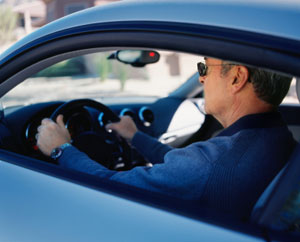
1. General Knowledge – A driver should be aware of the benefits of traffic safety programs and penalties for negligent driving. Benefits derived from periodic participation in traffic safety programs should not be forgotten, as yearly reminders of techniques to be followed are important. Penalties for negligent driving should be kept in mind and knowing and correctly applying the rules of the road is essential for good driving.
2. Personal Goals – Preventing collisions and driving as safely as possible should be the main objectives while driving. A concern for others and a general road awareness go hand-in-hand with these goals.
3. Time Management – Motorists should allow for sufficient drive time during long road trips and expect unforeseen problems. After potential trouble or road hazards are recognized, the driver should allocate additional driving time, if needed. Hurriedness and stress due to poor time management are major contributors to collisions. Not leaving oneself ample travel time increases the driver’s stress and detracts from his or her ability to operate a vehicle safely. Hurriedness while behind the wheel causes one to speed, take unneeded chances, and become a road hazard. A person should avoid driving while under severe duress, because a wandering mind cannot focus on the tribulations of the road.

Additionally, drivers should always observe maximum speed laws on highways and freeways and be aware of the basic speed law as it applies to city driving. The basic speed law states that a driver should never drive at a speed that is faster than is safe, and should neither impede nor block the flow of traffic. Drivers should be aware that “prima facie” speed limits apply when no visible or noticeable posts are present. Despite a lack of time due to any number of circumstances, basic traffic laws must always be followed.
4. Anticipation – In all aspects of driving, the operator must anticipate sudden changes, possible emergencies, and high-risk areas. High-risk areas to drive through include schools, playgrounds, parks, hospitals, housing communities, areas with stray animals, businesses, and municipal centers. Be especially wary for children at play. Various types of vehicular emergencies should also be considered, and corrective measures visualized. A cushion of safety should also be allowed, with proper vehicle spacing, anticipation of road hazards, and avoidance of known congested areas. A driver should be aware of alternate exits in case of an unexpected change or emergency situation.
5. Preparation – A driver must be prepared at all times for vehicle trouble. A vehicle should be properly equipped with road flares, a flashlight, a fire extinguisher, fuses, pencil and paper, change for a telephone call, a properly inflated spare tire, extra oil, and in case of a crash, a camera to document the scene. Preparation is often the only assistance a driver will ever need. (Review the emergency kits in Chapter 1 “Planning for Trips” and Chapter 2 “Winter Survival Kit.”)
6. Awareness of Traffic Conditions – Drivers must be aware of traffic conditions on chosen roadways and make intelligent choices about where they choose to drive. Decisions to drive on side streets versus through streets, one-way versus two-way streets, or certain unsafe roads in general can lead to or prevent traffic collisions. A safe driver will have a general awareness of which roadways are the safest to travel upon and will always make decisions with that knowledge in mind.
7. Body and Head Positioning While Steering – A driver needs to be properly positioned in the driver seat (sitting up straight with both hands on the steering wheel), with clear visibility over the steering wheel. The roadway must be visible without obstruction, and this relies on the position of the driver’s head and body in the vehicle. A driver must be buckled in the driver’s seat, with his or her eyes able to focus on all aspects of the road ahead.
8. Communication and Courtesy – Communication and courtesy on the road prevents collisions, saves lives, and makes driving a calmer and more enjoyable experience. To minimize confusion and irritation on the road, it is important to let the drivers and pedestrians around you know what you plan to do. Signaling and having working brake lights allows other drivers to know that you intend to slow down, turn or stop. For example, always turn on your signal lights before you turn or change lanes, and be sure to turn them off again after you complete your turn or lane change. Courtesy on the road is just as important because it mitigates aggression and promotes safe interactions between drivers. For example, when traffic conditions allow it, you can be courteous by letting another driver pull out of a driveway in front of you and into the line of traffic. You can also be courteous by keeping a safe distance from other drivers, not tailgating, allowing a driver to merge onto the freeway ahead of you, avoiding cutting off or forcing your way in front of other drivers, and by using a lane on the right or pulling off at a turnout to let faster drivers pass. When a right-of-way situation is unclear, pausing for a few seconds at an intersection to permit the other driver to pass safely is a simple, quick and courteous way of avoiding an accident. It is always best to treat other drivers the way you would want to be treated on the road.
Watch the following video for information on driving cooperatively.
In addition to being communicative and courteous, it is your responsibility as the operator of a motor vehicle to know and correctly apply the rules of the road. Courtesy, communicating your intent, and common sense may lead you to proceed correctly at, for example, a four-way stop; but knowing the rules that govern driver behavior at controlled intersections insures that you will do your part to avoid a collision at such an intersection.
Recent and Upcoming Changes to California Driving Laws

Below in this section are some of the new laws that you should know to help you keep up-to-date with the driving laws in California. Some are discussed in detail in the appropriate sections of this course.
Effective January 1, 2017
Increased Accident Reportability Threshold
- (California Vehicle Code 1656.2, 1808, 1808.1, 12517.1, 13369, 13558, 16000, 16000.1, 16020.1, 16020.2, 16075, 16251, 16430, & 16434)The minimum damage threshold for collision reportability has increased from $750 to $1,000. Drivers of a motor vehicle involved in a collision with property damages greater than $1,000 must submit a Report of Traffic Accident Occurring in California (SR 1) to DMV. The DMV is authorized to impose sanctions following an uninsured reportable collision.
Child Safety Seat Requirements
- (California Vehicle Code 27360) In addition to the pre-existing child passenger restraint system laws, any child who is under 2 years of age must be safely secured in a back-facing child passenger restraint system unless the child is 40 pounds or more or is 40 or more inches tall.
Use of Electronic Wireless Devices
- (California Vehicle Code 23123.5) Since 2008, it has been illegal to operate a motor vehicle while using a wireless telephone unless that telephone is specifically designed and setup to allow hands-free listening and talking, and is used in that manner while driving. This new law specifies exactly how people can touch and interact with their electronic wireless communication devices while driving. Now it is illegal to drive while holding and using a handheld wireless telephone or electronic wireless communications device unless the device is attached or mounted to the windshield, like a GPS device, or the vehicle’s dashboard or center console. The placement of the device cannot obstruct the view of the road for the driver. Additionally, the driver can only use their hands to operate the device with the motion of a single swipe or touch of their finger. These rules do not apply to manufacturer-installed systems that are built into the vehicle.
DUI Ignition Interlock Device
- (California Vehicle Code 23702) The Ignition Interlock Device pilot program in Alameda, Los Angeles, Sacramento, and Tulare counties has been extended until January 1, 2019.
Motorcycle Lane Splitting
- (California Vehicle Code 21658.1) This law authorized the California Highway Patrol (CHP) to start developing educational guidelines relating to lane splitting. The CHP will consult with agencies and organizations with an interest in road safety and motorcyclist behavior. Lane splitting is defined by this law as driving a motorcycle that has two wheels on the ground in the same lane or between rows of stopped or moving vehicles. This includes both divided and undivided streets, roads, and highways.
Public Transit Bus Lanes
- (California Vehicle Code 21655.1) This law makes it illegal for a driver to operate their motor vehicle on part of a highway that has been specifically designated for use by public transit buses. The exception to this rule is if the individual is directed to drive in the public transit bus designated space by a peace officer or official traffic control device. Additionally, drivers can also enter a public transit bus designated area if they must make a right or left turn or if they are entering or exiting a highway. However, there must be no signs prohibiting turns across the lane and the lane must not be separated by a physical barrier, such as a curb or fence. A local public transit agency will be responsible for posting signs that indicate the lanes are for “bus only” use.
Some of the law changes above are motivated by the on-going attempt to increase the effectiveness of existing child passenger restraint system requirements, while others focus on updating electronic wireless device use requirements and motorcycle safety. Regardless of the content, it is important to stay up-to-date on the traffic laws in the state of California.
Of course the overriding reason for changes in traffic laws and the passage of new ones is to continue to make our roads safer. Remember, though, that while passing traffic laws is the business of the state government, adapting your driving to newly recommended changes in driving techniques makes you a safer driver. We’ve previously seen that it is now recommended that proper steering technique starts with holding your hands at 8 and 4 or 9 and 3, not 10 and 2 as most of us were taught. Further, the once-accepted “one car length for each ten miles-per-hour” rule to establish a safe following distance has been discarded in favor of the three-second rule. The latter change helps prevent collisions and the former helps to prevent injury if you are involved in one.
Reasons for Traffic Laws

We seldom think about why we have traffic laws. But take a moment and imagine four drivers, in a hurry approaching an intersection. Imagine though that there are no signals or stop or yield signs at that intersection because there are no laws controlling the order and movement of traffic. Imagine too that all four drivers are in a hurry and are speeding and that there are no laws about how fast you can go, either on highways or surface streets. Now while it’s hard to imagine this happening today, it very well might have happened more than a century ago when vehicles could go no faster than 25 mph and roads in many places were dirt with uncontrolled intersections.
The need for safety gives rise to both a need to keep order and movement with respect to traffic and a need for common understanding of how to proceed in situations like those we’ve imagined. What gives order and movement in traffic and this common understanding are laws.
B. Drivers’ Attitude Toward State Driving Laws – Motor vehicle operators often look upon traffic laws and those that enforce them with disdain. People stress the negative aspects of laws rather than the positive. Traffic laws are in place to save lives. Drivers must understand that these laws are for their benefit. Without laws, anarchy would reign supreme, and the least of our troubles would be driving.
Drivers, on average, violate traffic laws over 400 times before they are actually cited. The occasional citation they do receive, in addition to their participation in a traffic safety program, usually reminds motorists that safer driving habits are needed.
Officers Working for Public Safety
Officers of the law are there to protect and serve the public. Respecting their presence and heeding their commands can only make the roads safer for everyone. Below are various types of officers you may encounter:
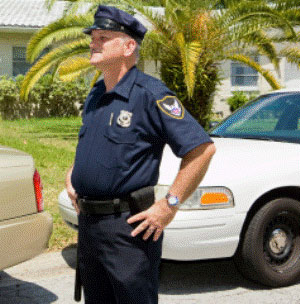
A. Traffic Officer – Traffic officers are primarily in charge of traffic safety, with their primary focus on maintaining clear and safe roadways.
B. Motorcycle Officer – Motorcycle officers are similar to traffic officers, but they operate on motorcycles.
C. Patrol Officer – Patrol officers are primarily patrolling and providing for public safety. Traffic matters are not their main focus.
D. Undercover Officer – Undercover officers are normally engaged in non-traffic activities, but they can also write tickets and make arrests.
E. California Highway Patrol – The CHP primarily patrols highways and freeways, with the majority of their citations written for excessive speed violations. Remember: Speed leads to collisions, which lead to fatalities.
F. Transit Police – Transit Police have full police powers to arrest and ticket, but normally patrol only certain areas where the rapid transit agencies they are affiliated with operate.
G. College Police – College/university police have full police powers to arrest and ticket, but normally stay within areas specific to their college or university campus.
H. Security Officers / Private Patrols – Security officers or private patrols may only make a citizens’ arrest and are not typically affiliated with any police agency.
Emotions, Stress, and Fatigue
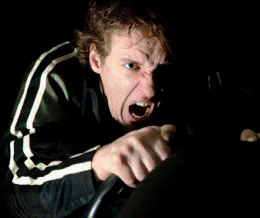
Stress caused by time constraints often result in traffic collisions, as do risky maneuvers taken to “make up” for lost time. Drivers’ actions behind the wheel are usually consistent with their behavior in daily life outside the vehicle. An angry person will often drive in an aggressive manner, while someone who is rested and calm will normally drive consistent with those feelings.
A. Emotional and Physical Factors- A contributing factor to collisions or poor driving in general are the emotions of a driver. Emotions we contend with have a direct impact on the way we operate a vehicle. The following are emotional and physical factors that affect driving, and the suggested ways to cope with them. Addressing each of the following potential problems before they manifest on the road will help prevent collisions.
1. Anger – The angry driver is an unsafe driver. Anger causes one to take chances, speed, and drive without control. Anger needs to be contained prior to driving, with an understanding that total focus is imperative behind the wheel. A level head is vital to driving. If you are mentally and physically well, your driving will reflect those attributes.
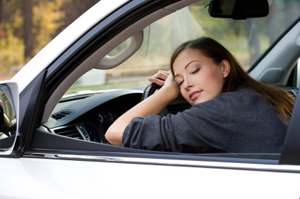
2. Sleepiness – Most people are aware of the dangers of drinking and driving, but not enough realize that driving while sleepy can be just as risky. Experts have even compared the risk of driving while drowsy to drunk driving. Police often pull over motorists who appeared intoxicated only to find out they were simply sleepy. It is essential to get adequate sleep and to recognize signs of drowsiness before operating a motor vehicle. Should you feel sleepy, pull off the road and get that needed rest before you attempt to continue driving. When the body is tired, you are less alert, and your chances of a crash are heightened, especially when driving late at night. If you are tired, the only cure is to remove yourself and your vehicle from the road and get that much needed rest. A tired driver is a danger to him or herself and all others on the road.
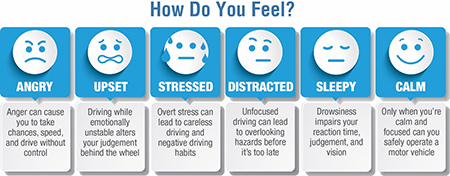
SLEEP DEPRIVATION EFFECTS FOUND TO BE THE SAME AS BEING DRUNK
- Drowsiness/fatigue may play a role in crashes attributed to other causes such as alcohol. About one million such crashes annually are thought to be produced by driver inattention/lapses.1
- Being awake for at least 18 hours is the same as someone having a blood content (BAC) of 0.05%.
- Being awake for at least 24 hours is equal to having a blood alcohol content of 0.10%. This is higher than the legal limit (0.08% BAC) in all states.2
Sleep Deprivation and New Survey Results 2011
Sleep deprivation causes an estimated 100,000 police-reported collisions per year, according to the National Transportation Safety Board. A study by the AAA Foundation for Traffic Safety found that those who sleep six to seven hours a night are two times more likely to be involved in a drowsy driving crash than those sleeping 8 hours or more, while people sleeping less than 5 hours increase their risk four to five times.
Mixing alcohol and sleep deprivation can be lethal. If a person drinks just one alcoholic beverage after getting only six hours of sleep, the effect on their driving ability is equal to consuming six alcoholic drinks on a full eight hours of sleep.
The National Sleep Foundation’s 2011 survey looked at the sleeping habits of American adults working at least 30 hours a week. Sleep deprivation in America continues to be widespread, which is unhealthy and counterproductive.
Some current statistics include:
- 15 percent of American adults say they sleep less than six hours on weeknights.3
- 28 percent of survey respondents admitted to driving drowsy at least once per month, and a whopping 36 percent had actually dozed off while at the wheel!4
The following types of drivers are at the greatest risk of having a collision:
- Drivers who are sleep-deprived.
- Drivers who drive long distances without rest breaks.
- Drivers who drive through the night or at other times when they are normally asleep.
- Drivers who drive alone.
- Drivers who drive on long, rural, boring roads and become hypnotized by the road.
To minimize fatigue, you should:

- Get a good night’s sleep.
- Avoid heavy foods before driving.
- Take regular breaks (every two hours) if you must drive for long periods of time, even if you do not feel tired.
- Never take drugs that make you drowsy or drink and drive.
3. Daydreaming – It is important to keep your mind focused on the task of driving while you are behind the wheel. If the mind wanders and your eyes are not focused on the road, you may not see hazards and won’t have enough time to react.
4. Stress – We all need stress in our lives. Perhaps that is surprising, but it is true. Stress is a physical condition in which your blood pressure and heart rate increase in response to a perceived threat. It is not necessarily a bad thing because it is an important component of life that helps make life interesting and challenging. Too much stress, however, can seriously affect your physical and mental well-being. In addition, stress often creates aggressive driving behavior. The strain makes it difficult to concentrate on the driving task or react in a timely manner.
To use stress in a positive way and prevent it from negatively affecting you, you should become aware of how you react to stressful events. The body responds to stress by going through three stages: 1) alarm, 2) resistance, and 3) exhaustion. For example, a car pulls abruptly into traffic in front of you. Your initial reaction could be one of alarm, which may include fear of a collision or anger at the driver who pulled in front of you. Your body physically reacts by releasing hormones into your blood stream, and in this stage your face gets flush, you perspire, and your arms and legs tighten up as you prepare to fight or flee from the situation. The resistance stage is where your body repairs the damage caused by the alarm stage. The exhaustion stage comes about when the alarm’s resistance cycle is repeated too often and the body does not have sufficient time to repair any damage. Exhaustion may be manifested in such things as migraine headaches, high blood pressure, backaches or insomnia. Although you cannot avoid stress completely, you can still minimize its impact. These tips can help you manage stress:
- Plan ahead. Planning and budgeting your time will give you more flexibility, reducing stress. Don’t wait until the last minute to do things.
- Exercise. Regular exercise will help keep you healthy and reduce stress.
- Change your routine. Try commuting during off-peak hours.
- Create a calming environment. Soothing music can calm you down, as will driving at a more comfortable pace (i.e. an increased following distance) and sometimes medication. A calming environment will also help keep your emotions from getting out of control. This sometimes means isolating yourself from your day-to-day problems temporarily or simply setting aside time to relax.
- Share a ride. Talking with someone who cares and who will listen can help sort out any problems and reduce internal stress. Sharing the driving responsibility will also help.
5. Physical Limitations – You should assess your own physical limitations prior to operating a motor vehicle. The inability to reach a vehicle’s clutch or turn indicator, for example, might contribute to a crash. Driving is truly a physical activity, and as with any other activity, your body is limited in what it can do.

6. Eyesight / Vision – Proper vision is important in most aspects of life, but in no area may it be more vital than while driving an automobile. As people age, most are affected by a deterioration of their eyesight. The ability to see things clearly may have once been taken for granted by motorists, but increased age or deteriorating vision will likely require corrective measures. Driving a motor vehicle with anything but the best attainable vision is simply a hazard. Ego or lack of recognition of poor vision can make the best driver dangerous behind the wheel. Although a vision test is required to receive a driver’s license, the time between renewal exams is often lengthy, and eyesight deterioration can occur during that time. Periodic visits to an optometrist or ophthalmologist should be part of a safe driver’s routine. Corrective glasses or contact lenses must be worn when poor eyesight warrants it. Commonly, drivers in need of corrective lenses find themselves squinting to see street signs, pedestrians or other cars. These warning signs may signal the need to see an eye doctor before a collision occurs.
7. Illness / Etc. – Some conditions may cause drowsiness or dizziness, and they can affect your driving. Drowsiness caused by illness or medications directly alters decision-making and the ability to safely operate a motor vehicle.
If you are ill and are thinking of driving, you should consider the following:
- Do not drive unless you really have to. You will then need to pay extra attention to the driving environment.
- As you will probably be fatigued, you should stop off the road frequently to rest.
- Be aware of any physical limitations caused by your illness.
- Drive at a reduced speed, but not so slow as to become a hazard to other drivers.
- Increase your following distance.
8. Alcohol Level – There is no more important piece of knowledge a driver can have than that he or she has had too much alcohol to drive safely. While you can’t test your own blood alcohol level to see whether you are legally intoxicated, you can have some basic knowledge about how much alcohol you’ve consumed and how it affects you. Remember, if you’ve had more than one 5 ounce glass of wine, one 12 oz. beer, or 1 ½ oz. of hard liquor within an hour of driving, you are going to have alcohol in your blood and thus be subject to the effects of drinking when you get in the car.
9. Medication – Any medicine, prescription or over-the counter, has the potential to affect your ability to focus and to drive safely. Medications that you take for colds and allergies can make you sleepy. Painkillers can have a narcotic effect. If you have to take medication before you drive, be sure to determine the effects of the medication by consulting with your doctor or pharmacist. It’s your responsibility to both find out what these effects are and avoid driving if you cannot do so safely. Before driving, you must not mix medications unless directed to by your doctor, take other people’s prescription medicine, or mix alcohol with any medication.
B. Recognition of Emotional / Physical Factors- Fighting fatigue while behind the wheel is never advisable. Driving while irritated, upset or shaken will substantially alter one’s judgment behind the wheel. The angry driver is an aggressive offensive driver, and as a result, he or she becomes a dangerous driver. Stressful conditions involving one’s personal or business life will affect safe driving and should be recognized as negative influences on driving habits. The driver should evaluate his or her state of mind before attempting the operation of a motor vehicle and should not drive when heightened stress, anger, emotions or fatigue are realized. When emotions are exaggerated or heightened, limiting driving activities can help prevent potential collisions and injuries.
C. Effects- The safe operation of a motor vehicle requires a person to be focused while behind the wheel, uncluttered by thoughts of aggravation and distress. The driver with a wandering mind caused by any one of the aforementioned effects has a decreased awareness of the road, a slower reaction time, and an overall lack of safe driving habits. This driver is more apt to make unsafe lane changes, speed, and take chances on the road. The ability to anticipate and determine imminent hazards and conditions is also adversely affected.
D. Accident Potential – It is statistically proven that the emotionally distressed or fatigued driver is more apt to be involved in a traffic collision than someone who is rested and clear-headed. A tired or disturbed driver or one with a cluttered mind has a decreased ability to avoid an automobile crash. Keep distractions within the vehicle to a minimum (such as children, pets, car phones, etc.), and never drive when drowsy or tired. Remember to concentrate on the road, not on other matters.
Road Rage
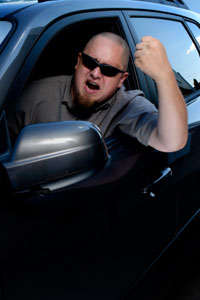
Aggressive driving behavior, including “Road Rage,” is a rapidly increasing problem affecting America’s drivers. This behavior is sometimes provoked by the actions of drivers when they tailgate, cut off others on the road, or use rude hand gestures. In most cases, however, road rage stems from the pre-existing attitude or mood of the drivers prior to getting behind the wheel. People often get into a vehicle when they are stressed or angry, and they then take out their problems on others with aggressive driving behavior. Drivers ignore the law, become discourteous, and have a basic disregard for others, often causing collisions or even fatalities. The preferred and suggested option for those dealing with a situation of road rage is to avoid the problem situation altogether and leave the scene as quickly as possible. Do not allow another’s anger and ignorance to affect you. The safest thing is to use your own good sense and protect your life. Many road rage killings result from a vehicle being used as a weapon or drivers using guns against others on the road!
Definitions
Aggressive driving is considered either a traffic or criminal offense, depending on the state. NHTSA defines this behavior as “the operation of a motor vehicle in a manner which endangers or is likely to endanger persons or property.” Aggressive driving behaviors include speeding, improper lane changing, tailgating, improper passing, cutting off others, and other forms of negligent or inconsiderate driving. Basically, aggressive driving is selfish, pushy and inconsiderate driving.
Aggressive driving, therefore, is driving in a way that endangers yourself and others on the road.
Road rage is considered a criminal offense. NHTSA defines road rage as “an assault with a motor vehicle or other dangerous weapon by the operator or passenger(s) of one motor vehicle on the operator or passengers(s) of another motor vehicle or vehicles precipitated by an incident which occurred on a roadway.” It is often the result of aggressive driving but can occur separately.
What Causes Aggressive Driving?
Aggressive driving is often a result of a competitive society, gridlock that seems to be unavoidable, and learned behavior from our parents, peer influence, movies and television. In many cases it results from frustration, which does lead to aggression in many situations. Gridlock is a source of frustration for many drivers; according to the Texas Transportation Institute, American urban drivers in 2015 spent an average of nearly 42 hours (or one work week) stuck on congested roads! Other frustrating situations include drivers who fail to signal and drivers who do not merge properly (also see “Common Motorist Irritants” below).5 Aggressive drivers are more likely to engage in risky behaviors, get into collisions, and have speeding violations. In fact, speeding is the most common offense committed by aggressive drivers.
Although aggressive driving can lead to road rage, it is possible to control yourself before you commit an offense. But this means that you must develop adequate coping techniques if you have trouble dealing with your anger so you do not succumb to road rage.
Common Motorist Irritants
- Tailgating to pressure a driver to go faster or get out of the way.
- Flashing lights in order to signal other drivers to move to another lane.
- Obscene gesturing.
- Changing lanes without signaling.
- Blasting the horn or cutting people off.
- Frequently changing lanes by weaving back and forth, or traveling in the passing or left lane at slower speeds, making it impossible for others to pass.
- Driving with the high beams on behind another vehicle or toward oncoming traffic.
- Slowing down after passing someone.
- Not making a right turn in the right-hand turn lane or not reacting quickly after the red light turns green.
- Crowded roads.
- Road work.
- Being in a hurry.
Don’t become a statistic… Don’t let road rage get to you!
Hints to Avoid a Dangerous Situation:
- Maintain good, safe roadside manners…no matter how others act around you.
- Always use your blinker (directional signal) to indicate when you are going to change lanes.
- Eliminate cellular phone usage while driving as you are required, by law, to do.
- Do not change lanes if your turn will impede the car in that lane – cutting off another driver is not only rude and unsafe, it will irritate and provoke that driver.
- If you become involved in an incident of road rage with another driver, you should first calm yourself down and remember that your safety is the primary concern. Simply leave the scene if an aggressive driver is threatening you before anyone gets hurt. If the other person follows you or persists in antagonizing you on the road, drive to a public area or police station and request help. Never go to your home!

California Vehicle Code 13210 (Road Rage) – This law provides for a driver’s license suspension for operators of motor vehicles convicted of specified assault offenses if the offense occurs on a street. Specifically, this law provides:
- That in addition to existing penalties, the court may order the suspension of the driving privileges of any motor vehicle operator who commits an assault on an operator or passenger of another motor vehicle, an operator of a bicycle, or a pedestrian when the offense occurs on a highway.
- The suspension period for this type of assault, commonly known as “road rage,” shall be six months for a first offense and one year for a second or subsequent offense.
- The court may, in lieu of or in addition to the suspension of the driving privilege, order a person to complete a court-approved anger management or “road rage” course, prior to reinstatement of the person’s driving privilege.
Some Significant Facts Regarding Road Rage
- The number of drivers on the road has grown faster than road capacity. There are too many drivers crowded on the roads!
- A study by the American Driver and Traffic Safety Association found that only about 35 percent of motorists have taken a driver’s education course, compared to approximately 90 percent in the 1970s. Carelessness caused by ignorance often provokes others.
- A 2006 survey conducted by the car insurer Response Insurance found that fully half of drivers who encounter aggressive drivers respond aggressively.
How to Handle an Aggressive Driver:
- Get out of the way and let them pass.
- Avoid direct eye contact.
- Never try to teach a lesson to another driver.
- Do not react to provocation.
- If you are followed, go to a safe, public place.
Who are the Aggressive Drivers?
According to the NHTSA, some common characteristics of aggressive drivers include the following:
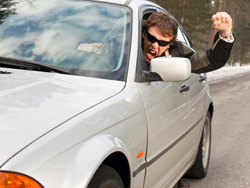
- They are high-risk drivers, more likely to drink and drive, speed, or drive without fastening their seat belts.
- Their vehicle provides anonymity, allowing them to take out their frustrations on other drivers.
- Their frustration levels are high, and their concern for other motorists is low.
- They consider vehicles as objects and fail to consider the human element involved; therefore, they seldom consider the consequences of their actions.
- They run stop signs, disobey red lights, speed, tailgate, weave in and out of traffic, pass on the right, make unsafe lane changes, flash their lights, blow their horns, or make hand and facial gestures.
Some statistics also point to the following profile:
- Male
- 18-26 years old
- A past criminal history
- Heavy use of alcohol and other drugs
- A history of violent behavior
- Highly stressed due to:
- Sleep deprivation
- Financial problems
- Relationship frustration
Not every driver with road rage fits this profile, as everyone has the capacity to become angry while driving a vehicle. Can you identify with any of the traits in the “Road Rage” profile? Are you between 18-26 years of age? Are you usually high-strung and stressed out? The most important aspect of this profile is that a person with a history of aggressive behavior is likely to develop “Road Rage.” If you attempt to maintain self-control while at the wheel, road rage shouldn’t affect you to a life-threatening extent. Even if we do maintain control and attempt to be calm, there is nothing we can do to control the other drivers on the road. But we should not provoke them into aggression.
The Five Types of Aggressive Drivers:
- The Speeder – this person wants to get from one point to another as quickly as possible and will become enraged if forced to slow down.
- The Competitor – this person sees the speeder coming and decides to race them.
- The Passive Aggressor – this person blocks other drivers and does not let them pass or merge in.
- The Narcissist – this person takes a dislike to another driver because of race, sex or type of car.
- The Vigilante – this person wants to make a violator of the rules pay.
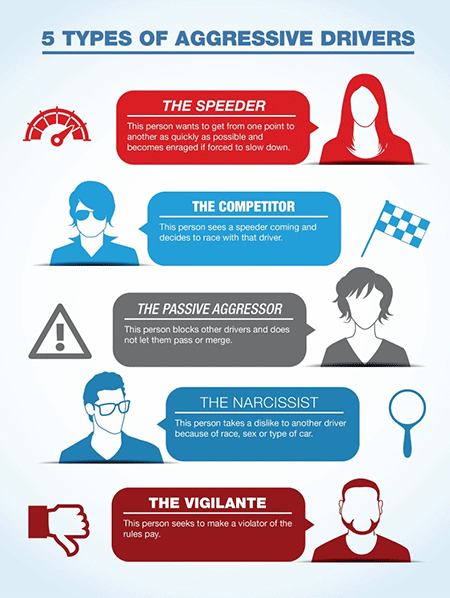
Please watch the following video about aggressive driving and road rage. As you watch, think about the factors that cause road rage and strategies for dealing with an aggressive driver.
Are You an Aggressive Driver?
Many drivers may not be aware just how aggressively they drive. The National Highway Traffic Safety Administration (NHTSA) developed one test that helps people determine whether they are an Aggressive Driver or a Smooth Operator. Take the test yourself and answer all of the questions with either YES or NO.
- Overtake other vehicles only on the left?
- Avoid blocking passing lanes?
- Yield to faster traffic by moving to the right?
- Keep to the right as much as possible on narrow streets and at intersections?
- Maintain appropriate distance when following other motorists, bicyclists, motorcyclists, etc.?
- Provide appropriate distance when cutting in after passing vehicles?
- Use headlights in cloudy, rainy, and other low light conditions?
- Yield to pedestrians?
- Come to a complete stop at stop signs, before right turns on red, etc.?
- Stop for red traffic lights?
- Approach intersections and pedestrians at slow speeds to show your intention and ability to stop?
- Follow right-of-way rules at four-way stops?
- Drive below posted speed limits when conditions warrant?
- Drive at slower speeds in construction zones?
- Maintain speeds appropriate for conditions?
- Use vehicle turn signals for all turns and lane changes?
- Make eye contact and signal intentions where needed?
- Acknowledge intentions of others?
- Use your horn sparingly around pedestrians, at night, around hospitals, etc.?
- Avoid unnecessary use of high beam headlights?
- Yield and move to the right for emergency vehicles?
- Refrain from flashing headlights to signal a desire to pass?
- Drive trucks at posted speeds, in the proper lanes, using non-aggressive lane changing?
- Make slow, deliberate U-turns?
- Maintain proper speeds around roadway crashes?
- Avoid returning inappropriate gestures?
- Avoid challenging other drivers?
- Try to get out of the way of aggressive drivers?
- Refrain from momentarily using High Occupancy Vehicle (HOV) lanes to pass vehicles?
- Focus on driving and avoid distracting activities (e.g., smoking, use of a cellular telephone, reading, shaving, etc.)?
- Avoid driving when drowsy?
- Avoid blocking the right-hand turn lane?
- Avoid taking more than one parking space?
- Avoid parking in a disabled space (if you are not disabled)?
- Avoid letting your door hit the car parked next to you?
- Avoid stopping in the road to talk with a pedestrian or other driver?
- Avoid inflicting loud music on neighboring cars?
Count the number of NO answers to see where you score below.
1 to 3: Excellent – You are a courteous driver and help make our highways safer.
4 to 7: Good – You have many good habits but a few that cause frustration to drivers.
8 to 11: Fair – You have some good habits but have room for improvement.
More than 12: Poor – You are a danger to yourself and other highway users.
Anytime you become selfish, irritated, bold or pushy in your vehicle, you stop respecting the rights and safety of other road users. Look at your NO answers – these are the habits that you need to change regardless of how you scored. However, a single test will tell you only part of your problem. The one you just completed looked only at your driving behaviors and not what’s inside you.
General Relaxation Techniques for the Road
If you can identify yourself as an aggressive driver, consider the following to keep from being too aggressive behind the wheel:

- Give yourself lots of time to get to your destination. Try to leave home in the morning as early as it takes to reach work in time without acting obnoxious or hostile on the drive there. If this means going to bed earlier at night, a simple half hour can make all the difference in your attitude when you wake up in the morning.
- Don’t take other drivers’ mistakes personally. Remember that every driver on the road has his or her own agenda for the day and some are more stressed out than others.
- Be courteous, be patient, and practice good driving habits. How would you like to be treated if you mistakenly sat in the right turn lane without making a right? Would you want the people behind you honking and making a commotion? Probably not. Lend others the courtesy you would like to receive on the road. Be patient with other drivers and be patient with your passengers.
- Listen to soothing music at a reasonable volume while driving. Loud music can be distracting to yourself and other drivers.
- Don’t retaliate. The one finger salute has caused more problems than it has solved. Honking, swearing, glaring, and yelling out of your window are not good conflict resolution techniques. Once again, attempt to remain calm and be patient.
- Leave enforcement to the police and don’t become a vigilante. Let officers of the law do their jobs. Officers are trained to handle a situation if it gets out of hand.
Pedestrian and Child Safety
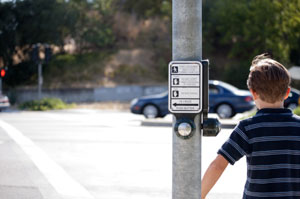
A. Responsibilities of the Driver – As a driver, you must be aware of pedestrians and act responsibly when around them. This includes yielding the right-of-way at all times to pedestrians. Never assume pedestrians see you or will stop for you. When stopping at intersections, you must make sure you are not blocking the crosswalk, whether marked or unmarked, in any way. If you block the crosswalk, even slightly, you are endangering pedestrians who have to go around your vehicle. You must yield to pedestrians by stopping and remain stopped until they have crossed the street safely before you proceed. If you are turning at a signal, including a red light, you must wait until pedestrians at intersections cross the street safely as they have the right-of-way at all times. You must also yield to pedestrians who are using a sidewalk when you enter or exit a driveway, whether this is your own driveway or a public one.
As far as pedestrians are concerned, your responsibilities as a driver include:
- Yield to pedestrians that are using crosswalks (whether marked or unmarked) and sidewalks.
- Obey and yield to traffic officers or crossing guards and any pedestrians they are directing.
- Be cautious around children, the elderly, and the disabled, as they may need more time to cross the street.
- Yield to all pedestrians carrying a metallic or white cane, with or without a red tip, or using a guide dog, and wait until they have crossed the roadway completely.
- Do not pass a vehicle that has stopped for a pedestrian. The pedestrian may be about to occupy the lane in which you are traveling and thus be directly in your path.
- When in doubt, always yield the right-of-way to pedestrians.
Remember: Pedestrian safety is a serious issue. A pedestrian is a person on foot or who uses a conveyance such as roller skates, skateboard, etc., other than a bicycle. A pedestrian can also be a person with a disability using a tricycle, quadricycle, or wheelchair for transportation. In California, pedestrian deaths occur in approximately 22 percent of all traffic fatalities.6 Drive cautiously when pedestrians are near because they may suddenly cross your path. Pedestrians may be at risk walking near hybrid and electric vehicles because these vehicles are virtually silent while operating. Use extra caution when driving near pedestrians.
Important: Blind pedestrians rely on the sound of your vehicle to become aware of your vehicle’s presence; so, it is important that you stop your vehicle within 5 feet of the crosswalk. Drivers of hybrid or electric vehicles must remain especially aware that the lack of engine noise may cause a blind pedestrian to assume there is not a vehicle nearby. Follow this cue: When a blind person pulls in his or her cane and steps away from the intersection, this gesture usually means for you to go. Keep in mind that pedestrians with white canes or seeing-eye dogs always have the right of way.
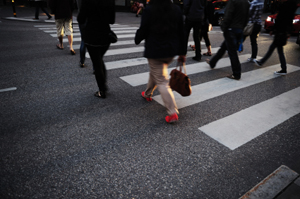
B. Rights and Responsibilities of a Pedestrian – As a pedestrian, you are expected to be responsible and respect the rules of the road by obeying traffic signals and using the appropriate crosswalks and intersections to cross the street. In addition, you should never impede or block the flow of traffic in any way. If you cross the street anywhere other than in a crosswalk (whether marked or not), understand that this may be illegal and dangerous. In any case, if you cross the street outside a crosswalk, you must yield to approaching vehicular traffic. If there is no sidewalk, using the shoulder of the road, walk on the left side of the road so you are facing traffic. This is not just a safety tip. Section 21956(a) of the California Vehicle Code states that no pedestrian may walk on any roadway outside of a business or residence district otherwise than close to his or her left-hand edge of that roadway. Additionally, a pedestrian may walk close to his or her right-hand edge of the roadway if a crosswalk or other means of safely crossing is not available or if traffic or other conditions would compromise the pedestrian’s safety when attempting to cross the road. You may not stop or delay traffic unnecessarily even while in a crosswalk, marked or not, so always yield to vehicles on the roadway.
A green light or a “walk” signal gives you the right-of-way. As always, never assume that you have the right-of-way. Be sure to look both ways and make sure all drivers see you and stop for you before crossing the street. A yellow or red light or a “don’t walk” signal tells you not to cross the street. However, if the “don’t walk” signal begins flashing while you are crossing the street, you may finish crossing. Do not suddenly leave the curb or other safe place and walk in the path of a vehicle so close it can hit you.
Pedestrian Signal Lights
Pedestrian signals show words or pictures similar to the following examples: “Walk” or “Walking Person” signal light means it is legal to cross the street. “Don’t Walk” or “Raised Hand” signal light means you may not start crossing the street. Flashing “Don’t Walk” or Flashing “Raised Hand” signal light means do not start crossing the street because the traffic signal is about to change. If the signal light starts flashing after you have already started to cross, finish crossing the street as quickly as possible.
Countdown signals indicate how many seconds remain for crossing. These signals allow pedestrians the flexibility to speed up if the crossing phase is about to expire. Some signals may provide a beeping or chirping sound or a verbal message. These signals are designed to help blind or visually impaired pedestrians cross the street. At many traffic signals, you need to push the pedestrian push button to activate the “Walk” or “Walking Person” signal light. If there are no pedestrian signals, obey the traffic signal lights.

C. Children – Each year, more than 167,000 children are injured as pedestrians in the United States.7 Children are at the greatest risk at the beginning and end of the school day, because they are on the streets during these times. Most of the injuries are a result of children running out into the street from between parked cars. Younger children are at the greatest risk. Some of the reasons include:
- They cannot judge the speed of moving cars or the distance between themselves and the cars.
- They act on impulse without thinking and do not always recognize an unsafe situation.
- Their field of vision is not as good as an adult.
D. Checking around your Vehicle Prior to Entering and Leaving
Backing up is always dangerous because it is hard to see behind your vehicle. When you are backing out
of a parking space:
- Check in front and behind the vehicle before you get in.
- Know where your kids are. Make sure they are away from your vehicle and in full view before moving your vehicle.
- If other children are nearby, make sure you can see them before backing up.
- Do not depend only on your mirrors or only looking out a side window.
- Turn and look over your right and left shoulders before you begin backing. As a safety measure, also look over your right and left shoulders again while backing.
- Back slowly to avoid collisions.
Please watch the following video that shows the unique dangers children face daily in traffic.
Parents should practice safety rules with their children and act as role models. Some tips to follow and share:
- Walk on sidewalks, and walk across the street only at designated crosswalks.
- Do not run into the street and never from between parked cars.
- If walking at night, do not walk alone, and wear bright clothing or something reflective.
- Look left, right, then left again before crossing the street, and always stop at the curb first before crossing.
- Teach your kids the traffic signs and signals and help them develop their safety skills.
While on the road, you should be extra cautious and drive slowly in all residential and school areas. Your children should not rely on drivers to follow the law — they must learn how to be safe pedestrians.
1 National Sleep Foundation. (2016). Facts and Stats. Retrieved from http://drowsydriving.org/about/facts-and-stats/
2 Center for Disease Control and Prevention (CDC). (2016). Drowsy Driving. Retrieved from http://www.cdc.gov/sleep/about_sleep/drowsy_driving.html
3 National Sleep Foundation. (2011). Annual Sleep in America Poll Exploring Connections with Communications Technology Use and Sleep. Retrieved from https://sleepfoundation.org/media-center/press-release/annual-sleep-america-poll-exploring-connections-communications-technology-use-
4 National Sleep Foundation. White Paper: Consequences of Drowsy Driving. Retrieved from https://sleepfoundation.org/white-paper-consequences-drowsy-driving/page/0/2
5 Texas A&M Transportation Institute. (2015). Traffic Gridlock Sets New Records for Traveler Misery. Retrieved from https://tti.tamu.edu/2015/08/26/traffic-gridlock-sets-new-records-for-traveler-misery/
6 National Highway Traffic Safety Administration (NHTSA). (2014). Traffic Safety Facts California 2010-2014. Retrieved from http://www-nrd.nhtsa.dot.gov/departments/nrd-30/ncsa/STSI/6_CA/2014/6_CA_2014.pdf
7 National Highway Traffic Safety Administration (NHTSA). (2016). 2014 Traffic Safety Facts – Children. DOT HS 812 271. Retrieved from https://crashstats.nhtsa.dot.gov/Api/Public/ViewPublication/812271



